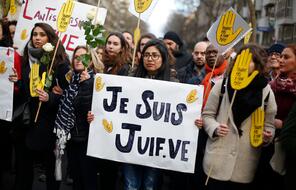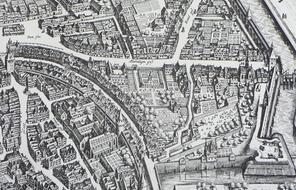Fan Culture at a Tottenham Match
At a Glance
Language
English — USSubject
- Social Studies
- Antisemitism
Historian of modern Jewish history, John Efron, describes Tottenham’s “Yiddo culture” as an invention by non-Jewish supporters of an imagined “collective tribal identity.” 1 He remembers his experience at a match at Tottenham’s home stadium, White Hart Lane:
In November of 2000, along with thousands of other soccer supporters, I made my way down the High Road toward White Hart Lane in Tottenham, a depressed area of North London. We were on our way to watch the local team, Tottenham Hotspur, take on Manchester City. The atmosphere on that sunny but crisp Saturday afternoon was decidedly carnivalesque, the air full of enticing smells—curry, kebabs, and old staples like fish and chips and lager. They all wafted together to indicate that while it had not entirely disappeared, the old England now had grafted on to itself other cultures and tastes, one result being that it sported a new, exotic, olfactory identity. Match day also provides a visual feast, with the streets surrounding the stadium a veritable sea of color, a marked contrast to the drabness that is midweek, N17. 2 Everywhere, hawkers sell all kinds of clothing and memorabilia in team colors, while boisterous supporters in team jerseys spill out onto the sidewalks from pubs giving full voice to an array of songs and chants expressing their devotion to Tottenham Hotspur and their unbridled hatred for the enemy.
As I was peering in the window of the Spurs Super Store, a gigantic emporium replete with turnstiles where one can buy everything from replica kits worn by teams from the past to mouse pads and baby booties in team colors, my eye suddenly fixed on two young men in Spurs’ team shirts. Where the number on the back normally appeared, these two had emblazoned on their outfits the expression, “Yid 4 Life.” Then I saw other fans streaming toward the ground, some with the more simple word “Yids” on their garments, others with the same word but in the patois of North London—“Yiddo.”
The game, which I had looked forward to for months, was now far from my thoughts. Instead, I could not shake the image of those inscriptions from my mind. What did they mean? Why had Tottenham Hotspur supporters adopted the word “Yids” (and variants thereof such as “Yiddo” and “Yid Army”) as a term of self-designation? My curiosity only increased after entering the ground. Taking my seat, I settled in and began leafing through the match program. Among other things, I was desperately looking for some reference to what I had just seen. My search was in vain, for the club neither officially recognizes nor endorses the use of this racist epithet. A mighty roar went up as the two teams emerged onto the pitch, and then suddenly, all around me, men, both young and old began chanting in unison, “Yids, Yids, Yids.” Throughout the course of the match, the air was punctuated by the deafening cry of “Yids” as it spontaneously began in one grandstand, spread to the next, and then began to swirl around the stadium, thousands of males willing their team to victory with this most bizarre of battle-cries. Horrified, amused, but above all baffled, I set about deciphering what it was I had witnessed. 3
- 1John Efron, “When is a Yid Not a Jew: The Strange Case of Supporter Identity at Tottenham Hotspur,” in Emancipation through Muscles, ed. Michael Brenner and Gideon Reuveni (Lincoln: University of Nebraska Press, 2006), 250.
- 2N17 is the postcode in North London where White Hart Lane Stadium is located.
- 3John Efron, “When is a Yid Not a Jew: The Strange Case of Supporter Identity at Tottenham Hotspur,” in Emancipation through Muscles, ed. Michael Brenner and Gideon Reuveni (Lincoln: University of Nebraska Press, 2006), 235-36.
How to Cite This Reading
Facing History & Ourselves, “Fan Culture at a Tottenham Match,” last updated January 5, 2017.
This reading contains text not authored by Facing History & Ourselves. See footnotes for source information.













